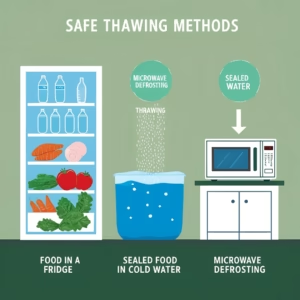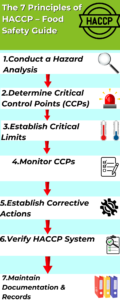Introduction
The food items which get spoiled quickly are called Perishable Food. It is important to handle perishable foods carefully, store them properly, and consume them on time , So that safety can also be ensured and there is no spoilage. If these foods are not stored properly, they can cause high bacterial growth and can cause diseases. In this article, we will provide information about perishable food examples, perishable food list, storage techniques, safety measures, and best practices to increase shelf life.
1. Understanding Perishable Foods
What Are Perishable Foods?
The food items which get spoiled quickly are called Perishable Food. To maintain freshness in these foods and completely prevent bacterial growth, we need refrigeration or freezing to store the food. foods have a high water content, making them more susceptible to spoilage and microbial growth. The moisture in these foods provides an ideal environment for bacteria, yeast, and mold to grow, which can spoil quickly if not stored properly.
Perishable Food Examples
- Dairy Products: Milk, cheese, yogurt, butter
- Meat and Poultry: Chicken, beef, lamb, pork
- Seafood: Fish, shrimp, crab, lobster
- Fruits and Vegetables: Berries, bananas, leafy greens, tomatoes
- Baked Goods: Bread, pastries, cakes with cream
- Eggs: Whole eggs, egg-based products
- Cooked Foods: Leftover meals, soups, gravies
Perishable Food List by Category
| Category | Examples |
|---|---|
| Dairy Products | Milk, Yogurt, Cheese, Butter |
| Meat & Poultry | Chicken, Beef, Pork, Turkey |
| Seafood | Fish, Shrimp, Crab, Lobsters |
| Vegetables | Spinach, Broccoli, Peppers |
| Fruits | Berries, Bananas, Grapes |
| Baked Goods | Bread, Pastries, Cakes |
| Eggs | Whole Eggs, Egg-based Products |
| Cooked Foods | Leftovers, Soups, Gravy |
2. Proper Storage Techniques for Perishable Foods
Refrigeration and Freezing Guidelines

- Refrigeration: Always store perishable foods at 5°C (41°F) or lower.
- Freezing: Maintain a temperature of -18°C (0°F) for storing frozen food items.
- Use Airtight Containers: Prevents moisture loss and contamination.
- FIFO Method (First In, First Out): Use older stock first to avoid wastage.
- FIFO Method (First In, First Out): Use older stock first to avoid wastage.
Specific Storage Tips for Fruits & Vegetables
- Do not refrigerate: Never keep bananas, potatoes, onions, garlic in the refrigerator.
- Store in High Humidity Drawer: Store vegetables like leafy greens, curry leaves, broccoli etc in high humidity drawer.
- Store in Low Humidity Drawer: Always keep fruits like apples, pears, berries in low humidity drawer.
- Keep separate from ethylene-producing fruits: Apples and bananas can ripen faster than other fruits, so keep them separate.
Shelf Life of Common Perishable Foods
| Food Item | Refrigeration (Days) | Freezing (Months) |
|---|---|---|
| Milk | 5-7 | Not Recommended |
| Cheese | 7-21 | 6-8 |
| Chicken | 1-2 | 9-12 |
| Fish | 1-2 | 6-9 |
| Eggs | 3-5 weeks | 6-12 |
| Cooked Meals | 3-4 | 2-3 |
3. Food Safety Guidelines for Perishable Items
Preventing Cross-Contamination

- Always keep raw meat separate from ready-to-eat foods.
- Use separate cutting boards for raw and cooked foods. Don’t use the same cutting board for both.
- Always wash your hands before handling perishable foods
Safe Thawing Techniques

- Refrigerator Thawing: Place the food in a leak-proof container; make sure the container is free of any leakage. This process can take anywhere from a few hours to a day.
- Cold Water Thawing: Place the food in a sealed plastic bag and submerge it in water; the water must be changed every 30 minutes; this process can take a few hours.
- Microwave Thawing: Use defrost settings; cook foods immediately after thawing.
Temperature Danger Zone
- Bacteria grow rapidly between 5°C (41°F) and 60°C (140°F).
- Avoid keeping perishable food in this range for more than 2 hours.
Signs of Spoiled Perishable Food

- Dairy: Sour smell, curdling
- Meat & Poultry: Slimy texture, foul odor
- Seafood: Strong ammonia-like smell
- Vegetables: Soft, moldy, discolored
4. Reducing Food Waste in Households & Businesses

- Meal Planning: Buy only the food you need
- Proper Portioning: Serve food in the correct quantity to reduce leftovers
- Composting: You can convert your leftover food scraps into compost.
- Donations: Donate extra food to shelters or food banks.
5. HACCP & Regulatory Compliance for Perishable Foods
HACCP Principles for Food Businesses

- Conduct Hazard Analysis
- Identify Critical Control Points (CCPs)
- Set Critical Limits
- Monitor Procedures
- Take Corrective Actions
- Verify Effectiveness
- Keep Records & Documentation
FSSAI Regulations (India)
- Food Safety Management System (FSMS) Compliance: It is very important for every type of food business, whether small or big, to follow food safety protocols.
- Labelling & Storage Guidelines: It is very important to have labels on perishable food packets with expiry dates as well as information on how to store them.
- Temperature control rules: Food businesses are required to have cold chain storage facilities.
FDA Regulations (USA)
- Cold Storage Standards: According to FDA regulation, perishable food must be stored in refrigerators at 40°F (4°C) or lower
- Labeling & Expiry Date Requirements: It is mandatory to use correct expiration labels. Any kind of misleading on labels is a serious offence.
- Hazard Analysis & Preventive Controls: Food facilities must comply with the regulations of the Food Safety Modernization Act (FASMA).
- Inspection & Compliance: FDA conducts regular inspections and ensures that businesses are following food safety laws.
6. FAQs on Perishable Food
1. What are some examples of perishable food?
Perishable foods include milk, eggs, meat, poultry, seafood, fresh fruits, vegetables, and cooked meals.
2. How do you safely store perishable food items?
Store perishable food in refrigerators below 5°C (41°F) and in freezers at -18°C (0°F).
3. How long can perishable food stay unrefrigerated?
Most perishable foods should not be left at room temperature for more than 2 hours.
4. How do restaurants manage perishable food waste?
Restaurants use inventory management systems, FIFO methods, and donate excess food to minimize waste.
5. What should you do if perishable food has a strange odor?
Discard the food immediately if it smells off, as this indicates spoilage.
6. Can vacuum-sealing extend the shelf life of perishable foods?
Yes, vacuum-sealing removes air, reducing oxidation and bacterial growth, which can extend shelf life.
Conclusion
Proper handling, storage and safety measures of perishable foods are very important so that foodborne illnesses can be prevented and food waste is also reduced. Following regulatory guidelines and best practices ensures food safety and remains suitable for our consumption.
About the Author
Vaibhav Deshmukh is a food safety expert with over 5 years of experience in food quality assurance and regulatory compliance. He specializes in HACCP implementation and food safety management. Linkedin Profile
read our other food safety related articles
- Quality Management System (QMS): A Complete Guide to Implementation & Benefits
- What is the Easiest Way to Recognize Food Contaminated with Spoilage Bacteria?

Pingback: From Trash to Treasure: How Sustainable Packaging is Changing the Food Industry - foodtechzone